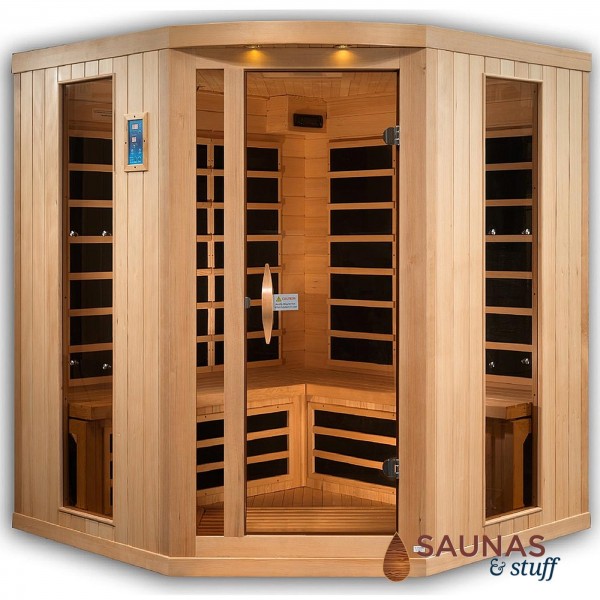
The “sauna” was developed in the 1960s, and has been around for a very long time. Typically, a traditional sauna, also known as a Finnish sauna, uses a constant heat source, such as fire and coal to maintain the high temperatures.
This heat source heats the sauna to around 180 - 198 degrees Fahrenheit making it unbearably hot and causing you to only sweat at the surface of the tissue. In a traditional sauna session, it is said that a person loses only about 3% of toxins and 97% of water.
Saunas have some really amazing health benefits, both physical and mental. The cycle of sweating and perspiring and cooling reduces muscle strains, improves your blood circulation, and can even decrease nervous tension.
A home sauna is a good option
if you are looking to relax within the comfort of your home, rather than go to
a gym or a spa.
If you’re having a hard time choosing the best
sauna for your home, make sure you keep some of these tips in mind.
- Sauna Size
If you want to enjoy your sauna session with some good company, you have to choose a sauna that is big enough. A sauna that is big enough will easily accommodate three people, without any body contact.
If you are looking for something like this, choose the model that works the best for you. To make sure the heat is not lost, a typical sauna will have a ceiling height of about 7 feet, and the room dimensions would normally be 4 by 4 feet and/or 8 by 12 feet.
Within, the sauna will have two benches at two different heights. An upper bench and a lower bench, with a difference of about 18 inches between both.
The functionality of the lower bench is mostly to provide a step to the upper bench as well as a footrest and has significantly lower temperatures for when the upper-bench area feels too hot.
2. The Location
If the sauna is inbuilt in the house, look for a space that is a little isolated from the rest of the house, so you can have a relaxed time in there. Space and location will also determine the size of your sauna.
Based on the layout of your home and where you would like to spend most of your time unwinding, your sauna can be placed anywhere from your basement to your attic, or even better, in the backyard.
3. Types of Wood for Saunas
The best interiors for a sauna are made of softwoods that remain cool and absorb all the steam, making the room more comfortable.
Cedar wood is widely used in North America, since it has a good finish, is sturdy and has a natural resistance to decay and it weathers extremely well in harsh environments.
Also, it is aromatic, which is never a bad thing. Other options of wood include clear aspen, vertical grain hemlock and redwood. Although redwood is barely used because it is priced very high and tends to darken very quickly.
4 . Sauna Heaters & Controls
The heart of a sauna comes from its heater. Wood-burning sauna stoves are traditional, but only if you live where electricity is not available. Otherwise, go for an electric heater for the sauna.
Small electric sauna heaters can be mounted on the wall while the bigger ones are freestanding. The space for your sauna will also determine the kind of heating options you can go ahead with.
There are many types of heaters that are used. The larger the heater, the better, since a larger surface area can operate at a lower temperature and produce a larger infrared wavelength, which is more penetrating.
Other than that, you can also choose a heater
that is made of stainless steel, and has been manufactured by a well known
manufacturer.
Some heaters have an inbuilt control system, with a silent 60 minute timer that shuts off incase you fall asleep in the sauna, which can otherwise be quite dangerous.
5.. Cost of Buying
Prices for saunas range from $1,000 to $1,500 for a two-person sauna, which is 4 ft by 4 ft. Prefabricated models range from $3,000 to $12,000 or more.
Eventually, the price of a sauna depends on the size, the model and quality of the wood, quality of the equipment and the materials used for the interiors and also, the quality of the entire product with respect to the space and facilities available in your home.
6. Sauna Safety
The human heart has to work extra hard to pump blood to the capillaries, and that is why, the intense heat in a sauna is probably not for everyone: especially those with heart conditions, diabetes, hypertension, thyroid or kidney problems, along with pregnant women.
During a sauna session, your body can release up to a quarter of a gallon of water, and to avoid dehydration you must drink water or fruit juice before and after. You can stop yourself from losing essential vitamins by consuming food that is rich in zinc and iron.
Do not deprive your body of water in an attempt to lose weight. Apart from the health issues, if not used properly, the sauna can be unsafe. The quality of the sauna determines a lot about the safety. The kind of material used on the interiors also determines how safe the sauna is.
Make sure that the wood used is the right one, and ensure it is cleaned thoroughly, so it doesn’t become slippery.
Since precut sauna models have become available to consumers, their sales and demand have shot through the roof.
In today’s day and age, everyone wants some time to unwind and relax without having to spend too much and pre cut saunas offer just that.
So go out there and get your sauna, without the hassle of getting carpenters and woodworkers on board! Although, keep these tips in mind!
Happy sauna to you!














